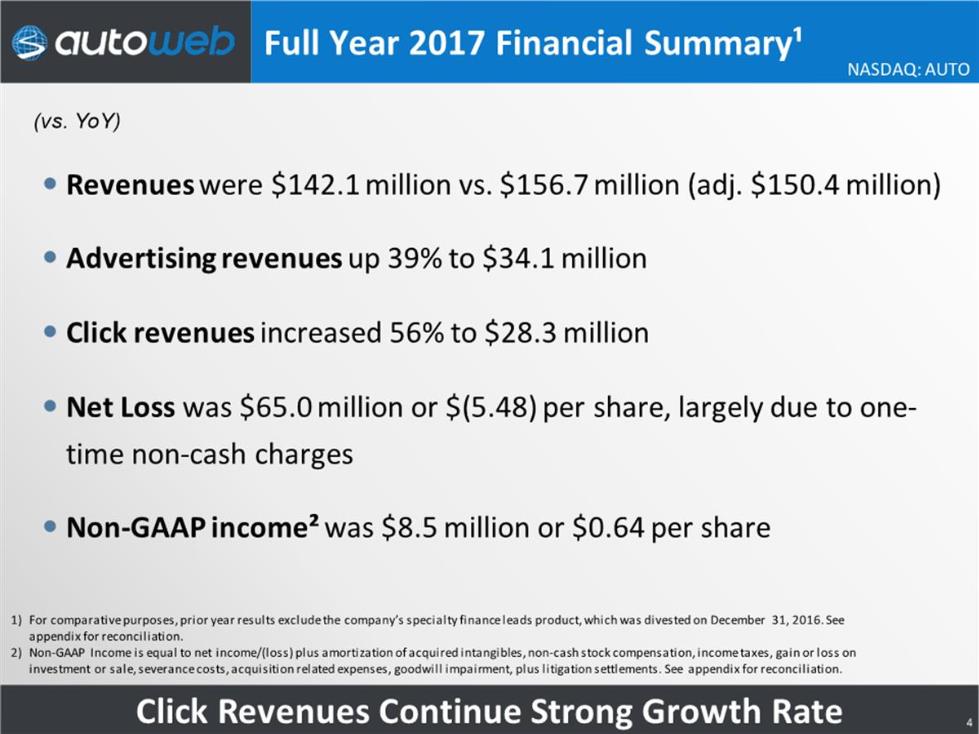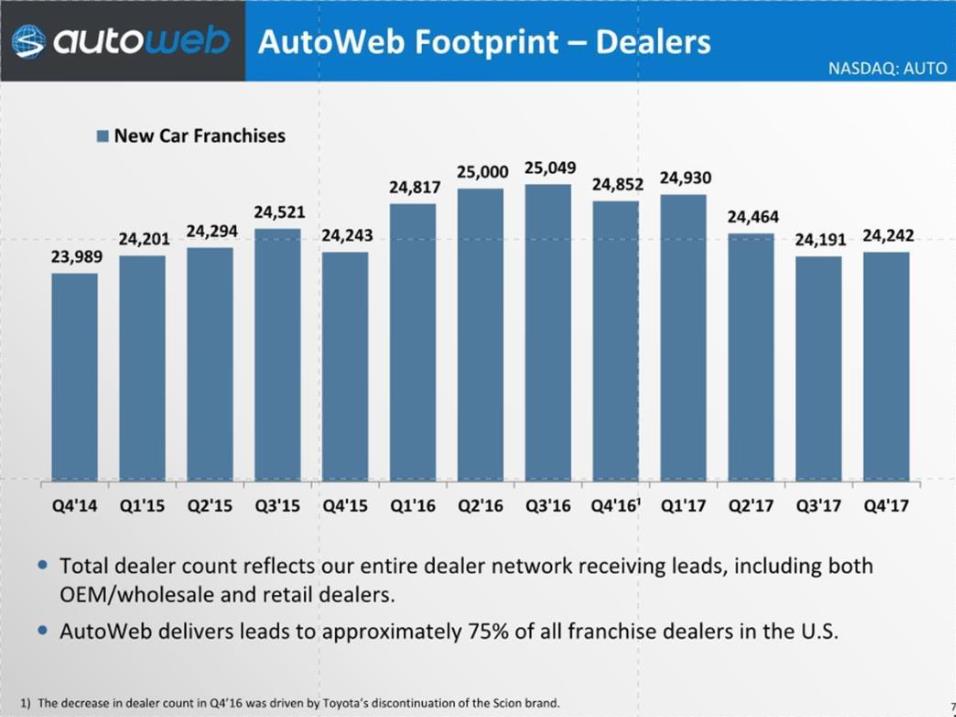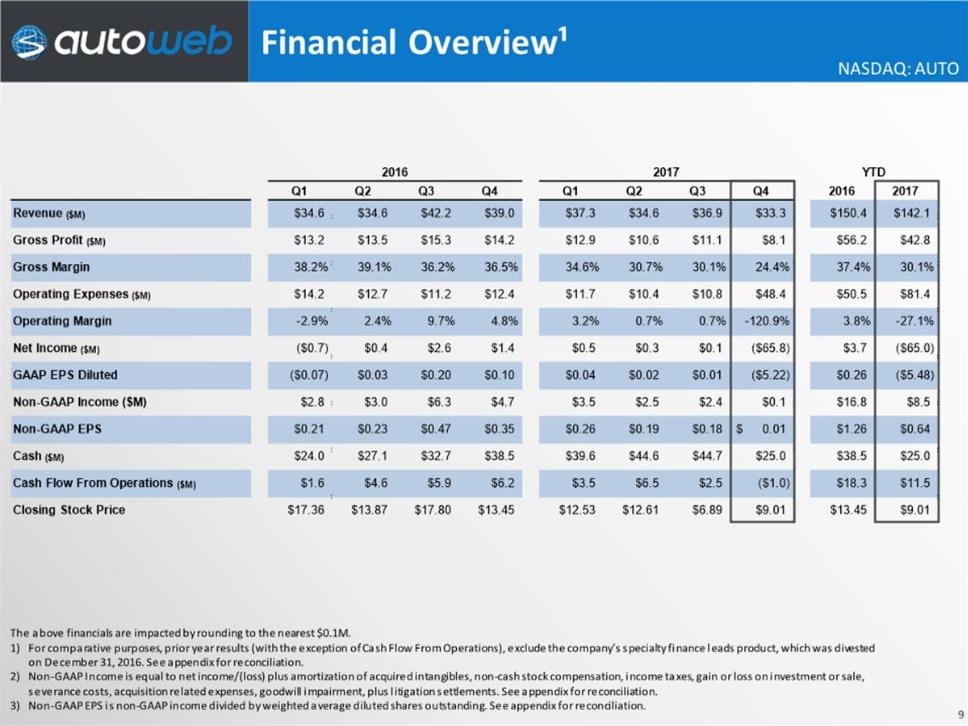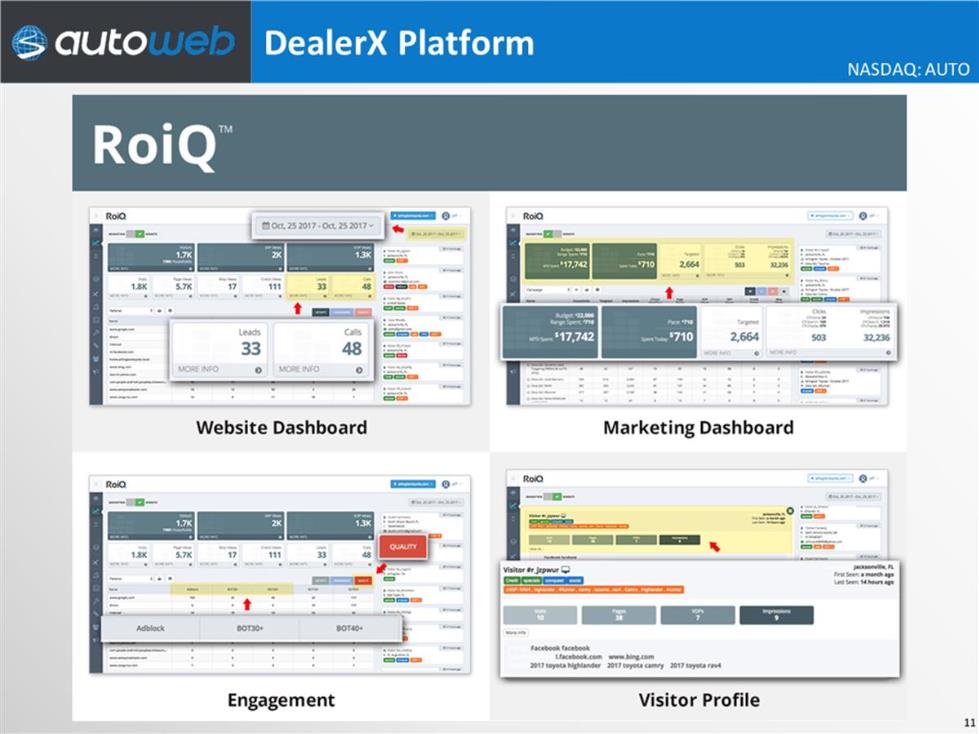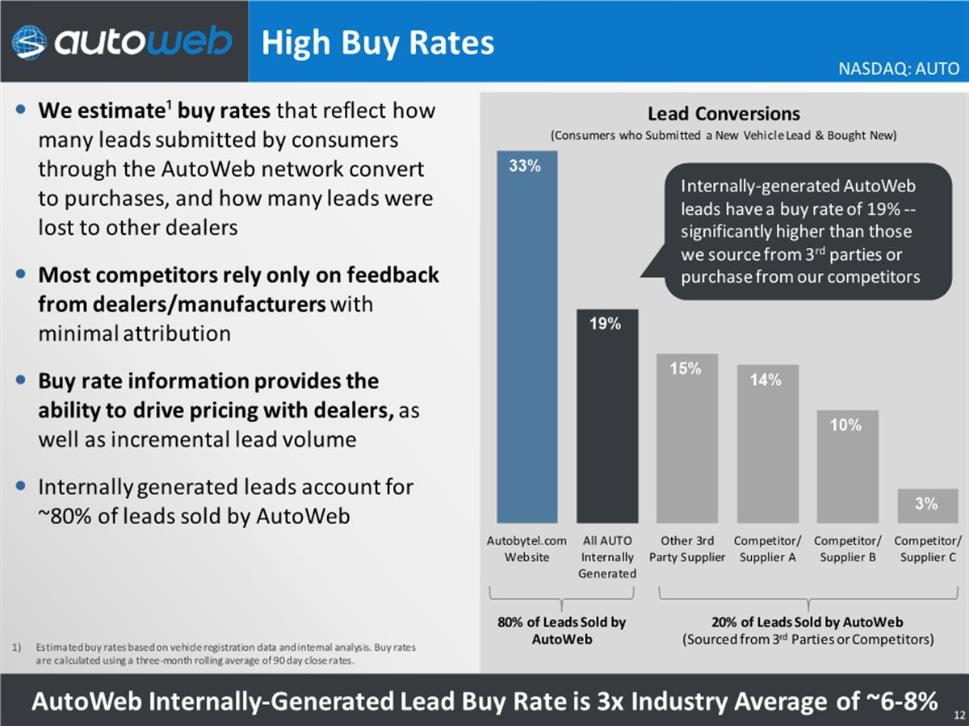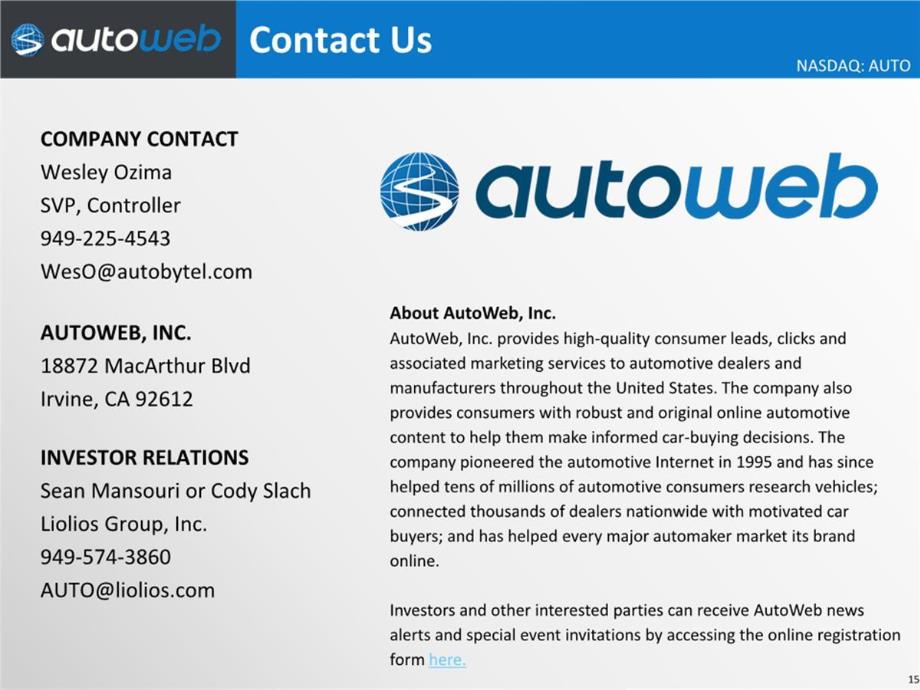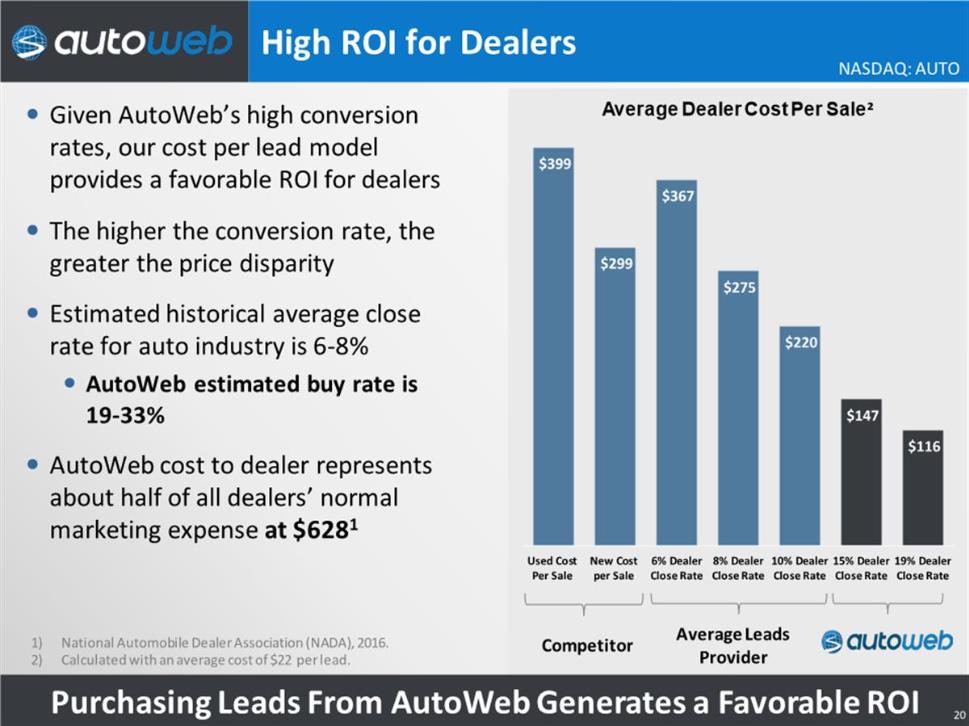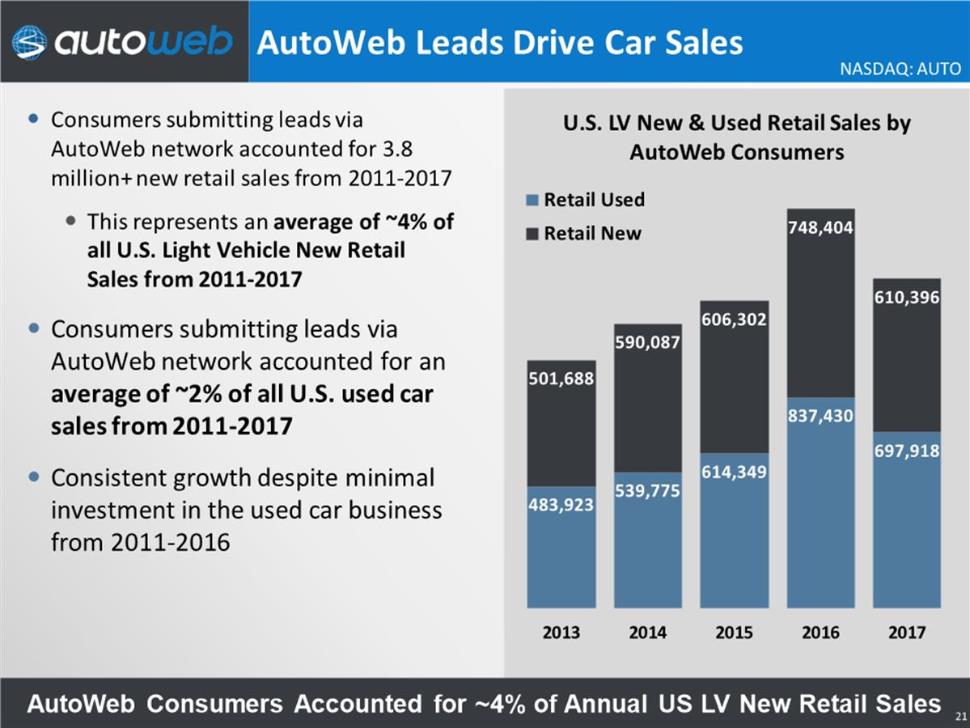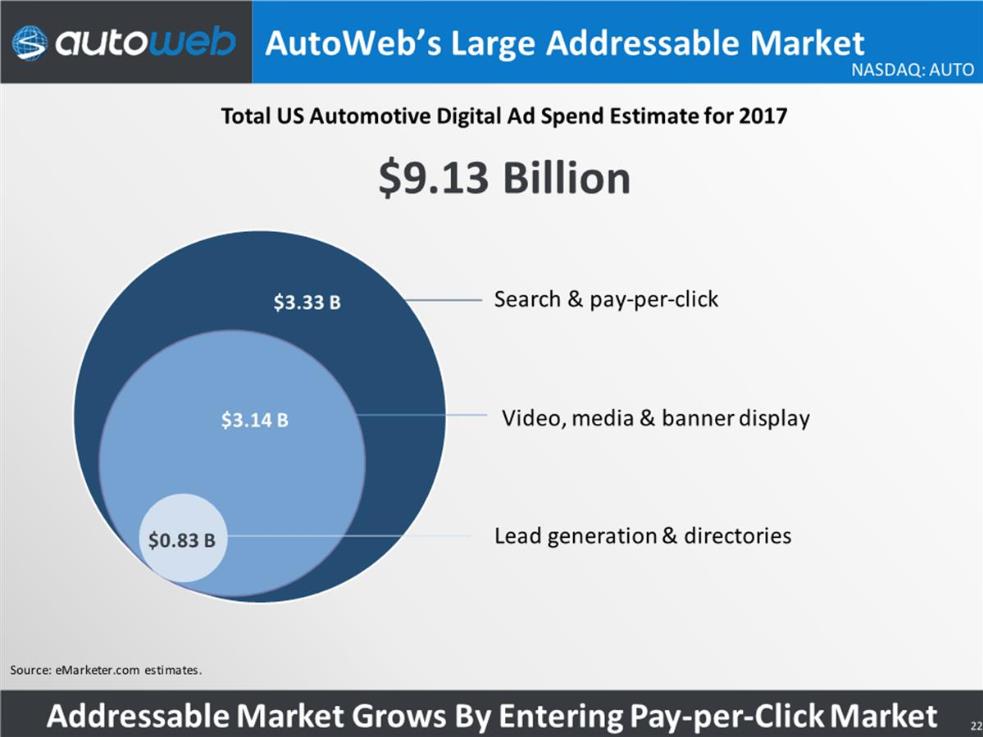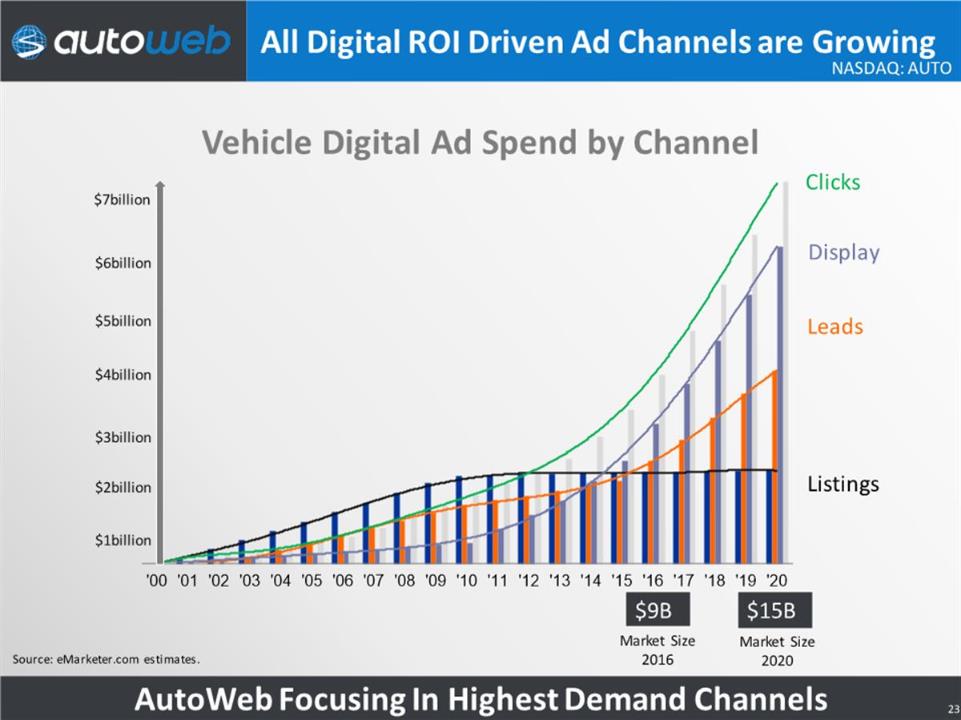Attached files
| file | filename |
|---|---|
| EX-99.1 - PRESS RELEASE - AutoWeb, Inc. | ex99-1.htm |
| 8-K - CURRENT REPORT - AutoWeb, Inc. | auto8k_mar082018.htm |
Exhibit 99.2
AUTOWEB, INC
Moderator: Sean Mansouri
March 8th, 2018
5:00 p.m. ET
OPERATOR:
This is conference
# 1396037
Operator:
Good afternoon,
everyone, and thank you for participating in today’s
conference call to discuss AutoWeb’s Financial Results for
the Fourth Quarter and Full Year Ended December 31,
2017.
Joining
us today are AutoWeb’s President and CEO, Jeff Coates; the
company’s CFO, Kimberly Boren; and the company’s
outside Investor Relations Adviser, Sean Mansouri, with Liolios
Group.
Following their
remarks, we will open up the call for your questions.
I would
now like to turn the call over to Mr. Mansouri for some
introductory comments.
Sean
Mansouri:
Thank you. Before I
introduce Jeff, I’ll remind you that during today’s
call, including the question-and-answer session, any projections
and forward-looking statements made regarding future events or
AutoWeb’s future financial performance are covered by the
safe harbor statements contained in today’s press release,
the slides accompanying this presentation and the company’s
public filings with the SEC.
Actual
events may differ materially from those forward-looking statements.
Specifically, please refer to the company’s Form 10-K for the
full year ended December 31, 2017, which we anticipate filing on or
before March 15, 2018, as well as other filings made by AutoWeb
with the SEC from time to time. These filings identify factors that
could cause results to differ materially from those forward-looking
statements.
There
are slides included with today’s presentation to help
illustrate some of the points being made and discussed during the
call. The slides can be accessed by visiting AutoWeb’s
website at autoweb.com. When there, go to Investor Relations and
then click on Events and Presentations.
Please
also note that during this call and/or in the accompanying slides,
management will be disclosing non-GAAP income and non-GAAP EPS, and
for year-over-year comparisons, prior year results with the
exception of cash flow from operations for all periods presented
are adjusted to exclude the company’s specialty finance leads
product, which was divested on December 31, 2016. These are
non-GAAP financial measures as defined by SEC Regulation
G.
Reconciliations of
these non-GAAP financial measures to the most directly comparable
GAAP measures are included in today’s press release and/or in
the slides, which are posted on the company’s
website.
And
with that, I’ll turn the call over to Jeff.
Jeffrey
Coats:
Thank you, Sean.
Good afternoon, everyone. As announced earlier today, the Board of
Directors and I have been discussing a succession plan for several
months. After more than a decade of leading AutoWeb and 20 years on
its Board of Directors, and after the board completes this process
and a new CEO is named during the coming month, I will be stepping
down to begin the next phase of my life.
Also
announced earlier today, Kimberly Boren will be stepping down as
Chief Financial Officer to pursue another opportunity. The company
will initiate a search for a new permanent CFO, but is in very good
hands with Senior Vice President and Controller, Wesley Ozima, as
Interim Chief Financial Officer, as he has served in
AutoWeb’s finance and accounting organization for nearly 14
years. We thank him (sic) [her] for her many years of service and
wish her all the best in her future endeavors.
Despite
recent struggles with our traffic acquisition, we’ve
dramatically increased the company’s addressable market over
the last several years through targeted acquisitions while
establishing AutoWeb as the largest supplier of online leads to
every major OEM in the country.
During
the fourth quarter, demand for leads and clicks from our customers
remain strong, however, we were unable to fully meet this demand
due to higher traffic acquisition costs. This led to lower revenue
and profitability than we had previously anticipated. While our Q4
results certainly were not acceptable, we believe we’ve been
taking the appropriate actions to address these traffic issues and
mitigate the impact to profitability. Just last month, we realigned
our headcount and expect to reduce operating expenses by $2 million
on an annual basis.
Before
commenting any further, I’d like to turn the call over to
Kim, and have her take us through the important details of our Q4
financial results. Kim?
Kimberly
Boren:
Thanks, Jeff, and
good afternoon, everyone. As noted in our press release today, for
year-over-year comparative purposes, the results for all periods
presented and discussed on our call today exclude our specialty
finance leads product, which was divested on December 31,
2016.
For
those of you following along with our earnings presentation, on
Slide 3, you can see that our fourth quarter revenue came in at
$33.3 million, down from $39 million in the adjusted year-ago
quarter. The decline in revenue was due to unfulfilled demand for
our leads as a result of higher traffic acquisition costs as well
as channel mix issues resulting from a lower retail dealer count,
partially offset by continued strong growth of advertising click
revenues, which increased 23% to $7.9 million.
Moving
to Slide 6. You’ll see that we delivered approximately $1.8
million automotive leads during the fourth quarter compared to $2.3
million last year, a reduction resulting primarily from the traffic
issues discussed earlier. Note that this lead volume reflects all
leads sold to both the retail and wholesale channels. As a
reminder, the retail channel comprises leads sold directly to
dealers whereas our wholesale channel, primarily reflects leads
sold to OEMs that are then distributed to dealers and their
corporate leads program at the OEM’s discretion.
And on
Slide 7, you’ll see that dealer count stood at 24,242 at
December 31, up from 24,191 at the end of Q3. Note that the
increase was largely driven by increased dealers on our OEM
wholesale program, partially offset by a decline in retail
dealers.
Similar
to our leads breakout, this dealer count reflects all of the
dealers we sell leads to, including both the wholesale and retail
channels for new cars.
Moving
on to advertising. As mentioned earlier, our advertising revenues
increased 14% to $9.2 million compared to $8.1 million in the
year-ago quarter. The increase was due to continued strong growth
in input revenues.
On
Slide 8, you’ll see click revenues increased 23% to a record
$7.9 million compared to $6.4 million in the same period last year.
The increase was driven by higher foot volumes into our wholesale
channel.
Now
moving to Slide 9. Gross profit during the fourth quarter was $8.1
million compared to an adjusted $14.2 million in the year-ago
quarter, with gross margin coming in at 24.4% compared to an
adjusted 36.5%.The decline was driven by higher consumer
acquisition costs as well as amortization costs associated with
DealerX. Total operating expenses in the fourth quarter were $48.4
million compared to an adjusted $12.4 million last
year.
The
increase was largely driven by a onetime noncash goodwill
impairment charge of $37.7 million. We evaluate the carrying value
of enterprise goodwill for impairment at a minimum on an annual
basis. During 2017, we performed our annual impairment tax,
effective October 1, by comparing the carrying value of AutoWeb to
its fair value based on market capitalization at that date. This
resulted in the $37.7 million charge.
On a
GAAP basis, net loss in the fourth quarter was $65.8 million or
$5.22 per share on 12.6 million shares compared to adjusted net
income of $1.4 million or $0.10 per share on 13.4 million shares in
the year-ago quarter. The decrease was driven by the aforementioned
goodwill charge as well as the $25.4 million noncash tax charge,
primarily related to the Tax Cuts and Jobs Act and a valuation
allowance on our remaining balance.
For the
fourth quarter, non-GAAP income, which adds back amortization on
acquired intangibles, noncash stock-based compensation, acquisition
costs, severance costs, gain or loss on investment or sale,
litigation settlements, goodwill impairment and income taxes, was
$0.1 million or $0.01 per share compared to an adjusted $4.7
million or $0.35 per share in the fourth quarter of 2016. The
decline was primarily driven by lower revenue in gross margins,
resulting from the aforementioned challenges with traffic
supply.
Cash
used in operations in the fourth quarter was $1 million compared to
cash provided by operations of $6.2 million unadjusted in the prior
year quarter. We also repurchased $0.7 million of stock during the
fourth quarter and have an additional $2.3 million authorized for
future purchases.
On
Slide 10, you’ll see that our cash balance remains strong,
with cash and cash equivalents of $25 million at December 31, 2017,
compared to $38.5 million at December 31, 2016. The decrease was
driven by debt paydowns, stock repurchases, the DealerX licensing
agreements and the usedtrucks.com URL purchased in 2017. Total debt
at December 31, 2017, was reduced to $9 million compared to $23.1
million at the end of 2016.
In
closing, it has been a pleasure being part of AutoWeb and leading
its finance and accounting organization over the last 10 years. And
I will do everything I can to ensure a successful transition of the
role to Wes and the team.
With
that, I’ll now turn the call back over to Jeff. It’s
been a pleasure.
Jeffrey
Coats:
Thank you, Kim. As
I mentioned earlier, we experienced significant challenges with
traffic acquisition during the fourth quarter. We were click
trending quite positively at the end of the third quarter before
hitting somewhat of a wall in October. We believe this was in large
part due to dramatically greater SEM spend from several of our
competitors, which ultimately drove up our prices to acquire
traffic. For context, we spend approximately $6 million to $7
million per month with our largest traffic suppliers, while
it’s our understanding that some of our competitors have each
been spending upwards of $25 million per month to acquire traffic
during Q4.
As
I’ve stated in the past, we remain committed to profitability
over growth and will not spend excessive amounts on traffic
acquisition to satisfy growth objectives. Ultimately, we do not
believe this estimated level of spending from our competition is
sustainable. So while our near-term results are being impacted, we
do expect market conditions to normalize over the course of the
year, which should then enable us to acquire traffic at a more
reasonable cost. Despite the rising cost, we will continue to work
with our traffic partners to optimize our SEM methodologies and
rebuild our high-quality traffic streams so that the company can be
prepared to return to growth as market conditions
normalize.
Due to
the competitive dynamics discussed and the anticipated management
transition, we cannot provide an exact timeframe to this
resolution. However, note that the company will prudently manage
its cost structure to maintain profitability as reflected by the
headcount realignment discussed earlier. A few weeks ago, Billy
Ferriolo resigned due to personal reasons. He was one of the
founders of the Tampa-based company we acquired in 2010, which was
instrumental in AutoWeb’s successful growth over the past
several years. Our strong team in Tampa remains in place and has
received increased support from Google to assist in the continued
recovery of our consumer acquisition efforts. We also wish Billy
all the best in his future endeavors as well.
We also
remain in the early stages of implementing the new DealerX ROiQ
platform. As you may recall, we licensed the ROiQ technology from
DealerX in October of last year. This technology records countless
consumer-driven behavioral events online and scores them in real
time to determine what content to show a consumer across multiple
devices. We plan to utilize this technologies to support both our
clicks and leads products as we can target the right consumer and
monetize the event in multiple ways.
In
addition to the monetary benefits, the DealerX platform provides us
with an entirely new source of traffic which builds upon our
strategy to diversify our consumer acquisition partners, especially
given the competitive dynamics mentioned earlier. It’s
important to note that we have the exclusive rights as to other
third-party service providers like ourselves to use the DealerX
technology to generate leads, traffic and other results and output
for the auto industry.
In our
clicks business, we continue to increase click volumes with
existing clients and have added new dealers, OEMs and advertising
customers. As I’ve mentioned in the past, our strong growth
in clicks up to this point has only come from a small number of
customers, so there’s plenty of room for ongoing growth. It
should also be noted that even though we have seen strong growth in
click revenue, this growth has been limited by the elimination of
lower quality traffic campaigns beginning in Q2 2017.
On
Slide 14, you’ll see that J.D. Power LMC Automotive is
forecasting 2018 total light vehicle sales to be just under 17
million units, a decrease of 1.4% from 2017. And retail light
vehicle sales are forecasted at 13.7 million units, which is a 1.7%
decrease from last year. As noted in our press release today, given
the anticipated management changes at this time, we will not be
issuing a 2018 business outlook.
Though
we find ourselves in a challenging period as we work to restore our
retail dealer footprint and traffic acquisition methodologies, we
continue to have robust relationships with our OEM partners and
they continue to have strong demand for our core leads and traffic
products. We are still in the early stages of expanding and
optimizing our proprietary AutoWeb traffic solutions and demand for
high-quality website traffic in the automotive industry continues
to grow.
Also,
while we’re committed to prudently managing our expenses
during this management transition, we are actively enhancing the
experience and capabilities of our strong portfolio of
consumer-facing automotive research sites, which includes
usedcars.com, car.com, autoweb.com, usedtrucks.com and
autobytel.com.
As we
continue to optimize our consumer acquisition practice, we are
embracing new platforms and strategies as we look to accelerate the
diversification of our revenue and traffic streams.
Operator, at this
time, we will open the call for questions.
Operator:
Thank you, sir.
Ladies and gentlemen, if you have a question at this time, pleas
press star then one on your touchtone telephone. If your question
has been answered or you wish to remove yourself from the queue,
please press the pound key. To prevent any background noise, we ask
that you please place your line on mute once your question has been
stated. Our first question comes from Sameet Sinha of B. Riley
FBR.
Sameet
Sinha:
A couple of
questions here. So one thing about traffic. So how -- I agree
you’re not giving guidance, but how are the trends been so
far in Q1? Are you seeing the same pressures you saw in Q4, and
that’s how we should be thinking about for the next -- for
the foreseeable future until a resolution is reached there? Or is
this -- are the trends worsening at this point? Secondly, can you
talk about -- you spoke about some cost-cutting initiatives. And
it’s -- where exactly are you taking those cuts? Some details
will be helpful.
Kimberly
Boren:
Sameet, the trends
have been choppy in the first quarter. So in January and February,
it was consistent with what we’re seeing in the fourth
quarter. March is improving significantly. And so it’s too
early to tell, but for your assumptions and modeling, I would
probably assume the same trends for the balance of the year. In
regards to the headcount that came out, it was really across all
functions.
It was
focused a little bit heavier on our operations in Los Angeles,
which was some of the consumer-facing and data operations,
we’ve gone ahead and consolidated those functions into
Irvine. But again, overall, it was across multiple
functions.
Operator:
Our next question
comes from Ed Woo of Ascendiant Capital.
Ed
Woo:
I had a question in
terms of the industry. 1% decline doesn’t seem like
(inaudible). Is there anything that we should be aware of
that’s going to affect on how dealer and OEM spends for leads
next year?
Jeffrey
Coats:
I don’t think
it will have a negative impact on the way dealers or OEMs spend for
leads next year. If anything, it may help. I mean what we normally
see is when foot traffic and the dealership starts slowing down,
they turn to their other traffic sources, lead providers, leads of
their own websites, some things like that. So I think we’re
in a period right now that is probably reasonably positive for
those of us in the digital marketing business.
Ed
Woo:
Great. And then
another question I have is -- last year, you guys were talking,
talked, about wrapping up your used car business. Is that -- how is
that going?
Jeffrey
Coats:
We are still
investing behind the used car business. It has been impacted
somewhat by our ongoing traffic issues, but it is still a priority
for us and it is still something that we’re expanding
resources on. And we do still believe it is a very big opportunity
for us as we continue to grow towards it.
Ed
Woo:
Great. And then my
last question is, obviously, you guys have made some changes to
kind of offset the traffic issues. But what do you think are some
of the biggest risks that could possibly change that? And how much
of it is you can get competitors spend versus any type of algorithm
changes by Google?
Jeffrey
Coats:
I would say, based
on our pretty extensive conversations with our friends at Google,
this is not algorithm changes. It’s just broad dollars coming
into the market. I think if you look back at what happened in the
-- probably beginning in the second quarter, but really
pronouncedly picking up in the third and fourth quarters,
particularly as some of the folks that we compete against came into
the market, other new models like (inaudible), which we do not
really compete against, but which is also spending heavily in the
SCM markets.
There’s just
massive amounts of traffic coming into the markets. Our
understanding is CarGurus, Cars.com, Autotrader. I mean we can see
some level of that in the search markets themselves, but you can
also read about it just by reading what their commentaries are and
their quarterly results and/or in the original S-1s.They certainly
want to come out of the gates with some strong growth rates, and a
really great way to do that is to spend a lot of
money.
And by
traffic, I think most of us in the industry, most of the people
that we talk to don’t believe, however, those spending levels
are sustainable. So it should settle down as we move into 2018, but
that does remain to be seen.
Operator:
Our next question
comes from Gary Prestopino of Barrington Research.
Gary
Prestopino:
I was going to ask
that you mentioned competitors that were spending, but fully aware
of what some of these other online platforms are doing. But I guess
the question that I would have is, is this a permanent kind of
secular shift change, Jeff? I mean you say that you don’t
think they can keep spending money like this, but
Autotrader’s not public. I know they’re having their
own internal problems, but Cars.com and CarGurus are, and
they’re basically meeting or exceeding their numbers, so at
least in this latest quarter when there was some heightened
spending. So any commentary you could share, your thoughts on that,
would be very helpful.
Jeffrey
Coats:
Gary, I certainly
don’t have a crystal ball, and I certainly don’t have
any inside knowledge. But from talking to people in the search
business and around the automotive industry that have seen things
like this happened in the past, the expectation is that they just
cannot continue to spend at these really extremely high levels for
extended periods of time. Now, right now, neither one of them, as I
understand it is -- or certainly one of them is not being measured
based upon on their bottom line margins at all, they’re only
being measured on growth.
And it
will maybe a little easier for them to continue to spend some of
those dollars, but again, we just don’t think it’s
sustainable over an extended period of time. We could be wrong. It
could be a secular shift. But from talking to experts and our
partners on the search side, they, at least, at this point,
don’t think that, that’s the case. We are expanding our
search partners. We are doing more with Facebook and Credio and
Instagram. We have also done this new license with DealerX that
we’re still in a very, very, very early phases of
implementing.
So we
remain hopeful that we can, in fact, get our traffic generation
back at the levels that we needed to be at in the margin profiles
that we needed to be. But obviously, we have some work cut out for
us to do that.
Gary
Prestopino:
Yes, okay,
that’s fine. And then could you -- Kim, could you maybe just
into -- with this goodwill impairment, with $38 million, which is
more than 30% of your preannounced equity value in the market. So
is this really pertaining to valuations that were assigned to the
acquisitions? And that the acquisitions are not delivering returns
that you expected? Or is it something else that’s closing
this write-down?
Kimberly
Boren:
That’s a good
question, Gary. I wouldn’t say that the acquisitions are not
delivering the returns that were expected since the goodwill is not
an asset that you amortize. I would say that because of the
performance in the lead side of the business, that impacted the
stock, which is the primary factor in the valuation. So
that’s what the driving factor is, less from a cash flow and
a business perspective and more so from a market
perspective.
Jeffrey
Coats:
And for what
it’s worth what the measurement date of October 1, which is
the measurement date we’ve been using every year for several
years, was very close to our 52-week low trading price. It’s
not right on it, but certainly very close to it. And so it’s
one of those “perfect storm” kind of situations. And
then you know the tax law changes which affected the write-downs we
had to take in our tax assets also exacerbated this, because it
puts us in a negative 3-year EBITDA position as part of doing all
that.
Operator:
Thank you. And
again, ladies and gentlemen, if you do have a questions at this
time, please press star then one on your touchtone telephone. Our
next question comes from Bruce Goldfarb of Lakestreet
Capital.
Bruce
Goldfarb:
Jeff, Kim, just a
few questions. The lead business, given the contraction of
‘17, when do you guys think -- when do you expect it to start
to stabilize?
Jeffrey
Coats:
We are still in the
midst of working to stabilize it. I think that it’s not a
demand problem that we have, it’s a supply problem. If we
equally had a demand problem, we’d be a whole lot more
worried about it. But it’s really almost entirely a supply
problem. So as we continue to rebuild our traffic supplies, as we
continue to improve the margin coming out of our traffic supply, we
should be able to rebuild leads.
I mean,
leads are pretty standard, they’re pretty basic. It’s
somebody’s name and telephone number and e-mail address and
maybe their address and no matter what a dealer does, no matter
what social methodology they use, no matter what a salesman does,
they need to capture that information to have an ongoing dialogue
with the consumer. And we’re kind of the front line of that.
So it’s not that leads are out-of-favor, it’s simply
right now, we’re just having a real supply
issue.
And we
do expect to work through that. We do expect to make progress on
that during the course of this year. Our new DealerX license, we
think will help, but we also think we’ll see some help coming
out of our own direct relationships with Facebook and Credio and
other players like that, as we began to generate more traffic from
them as well.
Bruce
Goldfarb:
Okay. And then, do
you expect any material contribution from used car leads in
‘18? And when do you think those -- so when do you think --
what part of the year do you think that’ll start to show or
start to have an impact?
Jeffrey
Coats:
I would say,
honestly, we will start seeing some benefits from used car leads
during the course of the year, but it’s not going to be as
robust as we would have initially expected, again, in part because
of the ongoing traffic issues. The traffic issues that use just the
way they do knew and so we definitely are still feeling that
impact, unfortunately.
Bruce
Goldfarb:
And then PTC has
performed well. And I know you’re not really projecting it in
‘18, but what -- I don’t know, could you guesstimate a
growth rate for ‘18 for that segment?
Jeffrey
Coats:
We would probably
still expect it to grow nicely during the course of this year. It
has impacted somewhat by our ongoing traffic issues, but we would
still expect it to grow at a double-digit rate this
year.
Operator:
Thank you. And
ladies and gentlemen, this does conclude our question-and-answer
session. I would now like to turn the call back over to Mr. Coats
for closing remarks.
Jeffrey
Coats:
Thank you all for
joining today. I know the conversation was not the most
heartwarming or what you wanted to hear. 2017 was a tough year for
us. But certainly, we made a lot of progress in identifying where
our issues are. We are working hard to address those during
2018.
I want
to thank everybody for joining us today. I also sincerely want to
thank our team of extremely dedicated employees for all of the hard
work and all of the extra hours that they’ve been putting in
over the many, many months we’ve been working through
this.
And in
closing, I’d also like to personally thank Kim Boren for her
insights and hard work and dedication to the company over the years
she’s been here. It has been a true pleasure to work with
you, Kim. So thank you very much.
Kimberly
Boren:
Thank you, Jeff.
Likewise.
Jeffrey
Coats:
Thank you,
operator.
Operator:
Ladies and
gentlemen, this does conclude today’s teleconference. You may
disconnect your lines at this time. Thank you for your
participation.
END



